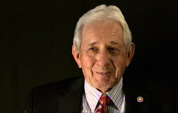1:24 | Ed Harrell recalls the bombardment of the island of Okinawa prior to the landing-force invasion.

Ed Harrell remembers his first impression of the USS Indianapolis and his first experience being at sea headed into combat during World War II.
Ed Harrell recalls the bombardment and successive invasion of Saipan during World War II.
Stationed aboard the USS Indianapolis, Ed Harrell remembers his ship being bombed by a Japanese fighter near Okinawa.
Ed Harrell describes the events leading up to the Battle of the Philippine Sea and the threat that kamikaze aircraft posed to U.S. ships during that battle.
Ed Harrell makes the case that invading the island of Peleliu was a costly mistake on the Pacific front.
Ed Harrell recollects the mystery surrounding a very important and dangerous package the USS Indianapolis was tasked with delivering to the Pacific front - the first atomic bomb.
Ed Harrell describes in detail the sinking of the USS Indianapolis from Japanese torpedoes, which left nearly 900 Sailors and Marines in shark-infested Pacific waters. Part 1 of 4.
After his ship was sunk by Japanese torpedoes, Ed Harrell continues his story of survival, fighting off hallucinations and sharks, while adrift in the Pacific Ocean. Part 2 of 4.
Ed Harrell continues his story of survival into the third day adrift in the Pacific Ocean. Part 3 of 4.
After being adrift in the Pacific for four days, Ed Harrell concludes his story of the sinking of the USS Indianapolis, which only a quarter of the crew ultimately survived. Part 4 of 4.
Ed Harrell describes the injuries he suffered after surviving the sinking of the USS Indianapolis and floating in the Pacific Ocean for four days, for which he received a Purple Heart.
Ed Harrell shares the efforts he and other former crewmembers went through to clear Rear Admiral Charles McVay's name after the admiral was court-martialed for his accused role in the sinking of the USS Indianapolis.